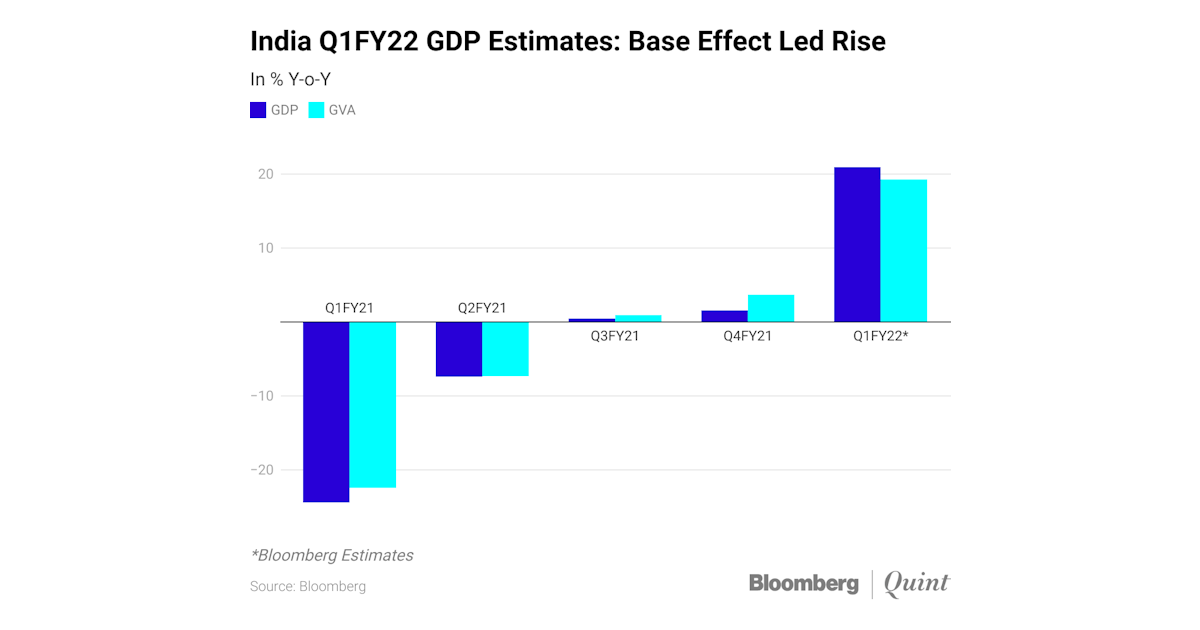Image: BloombergQuint
India Q1FY22 GDP: Prepare For The Illusion Of Record High Growth
According to median estimates of 23 economists polled by Bloomberg, GDP is estimated to rise by 21% in the first quarter, while GVA is expected to rise by 19.3%. In the January-March quarter, GDP rose by 1.6%, while GVA rose by 3.7%.
Growth in the first quarter of the current financial year (2021-22) will be sequentially lower as a fierce second wave of infections impacted activity. However, the extent of impact has been difficult to measure as lockdowns were localised this time around.
Following the second wave of Covid -19 and the restrictions in place during much of April-May 2021, GVA growth in Q1FY22 is projected at 17%, led by healthy exports, government capital spending and resilient farm sector demand, according to an estimate by Aditi Nayar, chief economist at ICRA.
The double-digit expansion expected in Q1FY22 in annual terms is deceptively high, as it benefits inordinately from last year’s contracted base. We forecast the GVA and the GDP to have shrunk by around 9% each in Q1FY22, relative to the pre-Covid level of Q1 FY20, highlighting the tangible distress being experienced by economic agents in the less formal and contact-intensive sectors.Aditi Nayar, Chief Economist, ICRA
Economists expect the divergence between GDP and GVA to remain. GDP equals GVA plus indirect taxes minus subsidies.
Given the sharp rise in the indirect taxes, the national statistics office may peg the GDP expansion at a relatively higher 20% for Q1FY22, Nayar said.
Rahul Bajoria, chief India economist at Barclays, said that second wave of Covid-19 infections acted as a stumbling block to the robust recovery that was underway. Still, the economic damage appears to be less than previously expected, Bajoria said, forecasting GDP growth at 21.2% for the quarter.
Along with a divergence between GDP and GVA because of strong tax collections, a significant gap between the tradable and non-tradable or services sectors is expected as well. This is because a number of state lockdowns permitted manufacturing and logistics activity to continue even though high contact services were shut down.
Key Components of The GDP
Agricultural output was resilient during the quarter, said Radhika Rao, economist at DBS Bank.
In addition, rural wages benefited from the record procurement of cereals, high food prices and employment support schemes, Rao said. Non-farm wage growth, however, likely felt the heat from slower industrial and service activity, she added.
Uncertainty persists here, too, as infections spread deeper into rural areas in the second wave.
Annual growth in the rural sector is likely to slow modestly in the quarter, as second wave spread deep into the rural countryside, according to Bajoria, who estimates GDP growth in agriculture and allied activities at 2% in Q1FY22 compared to 3.1% in the preceding quarter.
In contrast, the manufacturing and construction sectors are likely to lead the recovery, as consumption of steel and cement remained robust, driven by both higher government spending and export demand, Bajoria said. While manufacturing is forecast to grow by 53% on an annual basis, construction is expected to rise by 70%, according to Barclays' estimates.
Services will be a mixed bag, more adverse for contact intensive sectors, but the overall impact is expected to be less severe than during the first wave, Rao said.
Despite continued expansive government expenditures, output in the public administration sector is expected to contract, as a large of share of the spending is transfer payments, which will not contribute to GDP, according to Bajoria.
On the expenditure side, consumption demand was likely affected in the early part of the quarter, said Rao. Investment growth is expected to benefit from higher public capex in the quarter, up 26% on an annual basis and a strong 77% compared to the pre-pandemic April- June 2019 quarter, Rao added.
Since June, economic activity has picked up materially as curbs were slowly lifted. Concurrent indicators, such as the Nomura's Business Resumption Index, have surpassed pre-pandemic level.
Cyclical tailwinds by way of stronger global growth, the approaching festive season, supportive financing conditions, recent dearness allowance adjustments and an improving vaccination pace are expected to help growth in the second half of the ongoing financial year, Rao said.


No comments:
Post a Comment